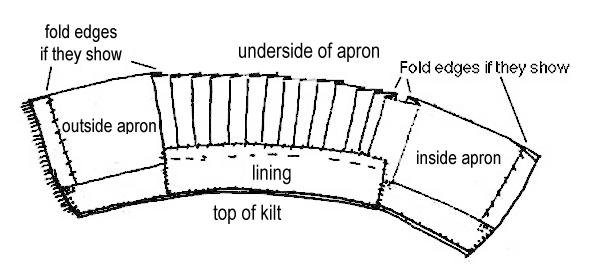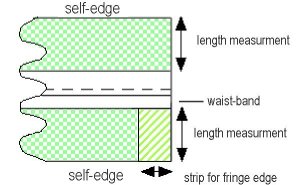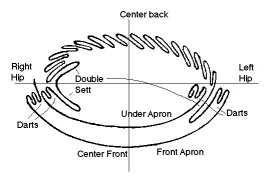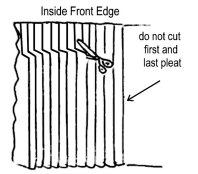[From Bobbie Suttie, images
copyright Jan Bruyndonckx and used with permission]
A Kilt is basically a pleated, wrapped skirt.
The back half of the kilt is pleated, the front half (apron) is the made
of two overlapping panels. A true kilt is completely handmade.
There are some small variations in my version, which I have added for
ease of wear, such as adding Velcro across the front of the apron.
The expression “The Whole Nine Yards” comes from the fact that a large
man’s kilt is made of a nine-yard long piece of tartan material
(Editor's note - this is one theory... see references below).
Since
high quality tartan costs $55 or more per 60-inch wide yard (yielding 2
yards of kilt material) you can see why a kilt is a
lifetime investment.

Why does a kilt need so much material?
A single pleat is made up of a full sett (pattern) width, with an
average one-inch exposed pleat. The pleating can be done “to the sett”,
duplicating the pattern, or regimental “to the stripe”. If the size of
the sett were 8 inches, one pleat would use 9 inches.
42-inch hip measurement requires 4 yards of
double-width tartan.
| 21 inches of apron x 2 | 42 inches |
| 21 inches of pleating x 9 inches (8 inch sett + 1 inch exposed pleat) | 189 inches |
| Total | 231 inches |
| add 20% for additional pleating and centering the apron pattern. | 46 inches |
| Total Inches needed | 277 inches |
| Divide by 72 (36x2 double width) | 3.86 yards – rounds to 4 yards. |
Less material is needed if the sett is smaller. A 6-inch sett would
equal 3.15 yards.
A larger man with 56-inch hip or waist measurement would require just
over 5 yards of 8-inch sett tartan.
A child or dancer’s kilt would look best if made with a 6-inch or
smaller sett, keeping the pattern in proportion to the size of the
wearer. A kilt for a child with a waist measurement of 26 inches,
using tartan with a 6-inch sett could be made with 2 to 2 ½ yards of
tartan.
Measurements Needed: Hip, Waist, and Kilt Length
Hip and waist meaurements determine the pleating needed. The length of
the kilt is measured from waist to mid-knee, adding 2 inches for a
higher rise (waist) if a wide kilt belt is to be worn.
Fitting hint: Pre-make the lining by cutting 1 yard of heavy duck
fabric into 10-inch widths. Wrap one section around the back of the
person being fit, stopping at the side seams of the person’s apparel.
Attach a section at this side seam on both the left and right side,
wrapping around the front until each piece meets the opposite seam.
Safety pin these pieces together, pinning back the ends of the apron
sections. You have now custom fitted the lining to be used later. You
can fit the pleats and the aprons to this lining as you are making the
kilt. Any increases or decreases in waist compared to hip can be easily
determined by how the back piece is fastened to the apron sections.
Preparing the Material
 True tartan material has a finished selvage edge, which would be used as
the bottom (hem) of the kilt. If the material doesn’t have a finished
edge you should start by hemming the material at both top and bottom
edge making sure you hem at the same place on both sides so that when
you sew them together (end to end) the pattern and depth of the hems
match. Cut material into two strips wide enough to measure from waist
to bottom of the hem. This will leave a long center strip that will be
partially used for the waistband. Sew the two wide hemmed pieces
together, matching the pattern of the sett. Finish the top edge of the
material by serging, running a zigzag stitch, or using an anti-fraying
liquid like Fray Stop or Fray Check.
True tartan material has a finished selvage edge, which would be used as
the bottom (hem) of the kilt. If the material doesn’t have a finished
edge you should start by hemming the material at both top and bottom
edge making sure you hem at the same place on both sides so that when
you sew them together (end to end) the pattern and depth of the hems
match. Cut material into two strips wide enough to measure from waist
to bottom of the hem. This will leave a long center strip that will be
partially used for the waistband. Sew the two wide hemmed pieces
together, matching the pattern of the sett. Finish the top edge of the
material by serging, running a zigzag stitch, or using an anti-fraying
liquid like Fray Stop or Fray Check.
Marking the Outside Apron
The outside kilt apron will buckle on the right side. The pattern of
the tartan needs to be centered properly. Fold under at least 6 inches
at the beginning, and then make a deep, double-width pleat on the left.
Fasten with a safety pin at the hip measurement.
Continue pleating with single-width pleats, (see Pleating the Kilt
below), continuing to safety pin at the hip. Pin in a wide, double sett
width box pleat at the opposite end of the pleating. Next measure the
inside apron to match the outside apron, and pin back the end.
Pleating the Kilt
 Think of a deck of cards, which have been fanned out. Many cards
overlap with only a narrow part of each card exposed. Each hidden part
of the card represents 8 inches of fabric doubled for the pleat. The
exposed part would be aprox. 5/8 to 1 inch. Mark one sett width on a
piece of cardboard. Divide the pattern of the sett into equal parts. A
section of two wide strips of color with a narrow stripe in the middle
looks best divided in 3 sections, centering the strip in the middle
section. An 8-inch sett may be divided in 8 or more sections. This
piece of cardboard can be your measuring tool as you pleat.
Think of a deck of cards, which have been fanned out. Many cards
overlap with only a narrow part of each card exposed. Each hidden part
of the card represents 8 inches of fabric doubled for the pleat. The
exposed part would be aprox. 5/8 to 1 inch. Mark one sett width on a
piece of cardboard. Divide the pattern of the sett into equal parts. A
section of two wide strips of color with a narrow stripe in the middle
looks best divided in 3 sections, centering the strip in the middle
section. An 8-inch sett may be divided in 8 or more sections. This
piece of cardboard can be your measuring tool as you pleat.
To duplicate the pattern of the tartan you overlay the edge of the pleat
over the matching pattern in the next sett. Fasten each pleat at hip
level with a safety pin. Continue pleating until the desired width is
pleated.
Hip to Waist Adjustments
Darts can be pinched in at each side of the apron pieces, keeping the
first and last pleats straight on grain. This will adjust the apron for
one of the half waist/hip difference. The remaining half of the
difference should be spread equally between the pleats, using safety
pins. You may want to mark the angles of the pleat adjustment, with a
temporary fabric marker, where needed to ensure a straight stitch.
Basting In the Pleats
Do 2 rows of basting, approximately ¼ and ½ of the way up from the
bottom edge of the fabric. You can use a running stitch, catching the
edge of each pleat. This will make the material more compact and easy
to work with during sewing, as well as making steam pressing easier.
Stitching the Pleats
Use a blind (felling) stitch, starting at the bottom (hip point) of the
pleat. Fasten the thread ½ inch from the reverse edge of the pleat,
start with 2 stitches to fasten the bottom, and then run the needle
under 3 threads of the bottom material, and then straight
up to the top material of the pleat. You then run the needle through
the top material aprox. 3 threads, back down to the bottom. This
produces aprox. 10 stitches per inch.
Trimming the Back of the Pleats
 On the inside of the kilt trim excess material at top of each pleat,
from waist to 1 inch above the hipline. This strip would be 1 ½ to 2
inches deep, removing the bulk of the material from the inside.
On the inside of the kilt trim excess material at top of each pleat,
from waist to 1 inch above the hipline. This strip would be 1 ½ to 2
inches deep, removing the bulk of the material from the inside.
Adding Fringe
Cut a 3 inch wide piece of material the length of the kilt. Fold this
piece in half to give a double thickness to the fringe. This will be
sewn into a doubled (Z – shaped) edge folded in the right side of the
apron. Once this is sewn in place you can fringe it by removing the
vertical threads.
Adding the Waistband
Cut a 5 inch wide strip for the waistband. Starting on the beginning
edge of the outside apron matching the pattern of the material. Turn
the bottom edge of the waistband strip under. ½ inch and stitch 1 to 1 ½
inches from the top edge of the apron using the blind (felling) stitch.
Overlap the remaining width over the top of the kilt. The lining will
cover up this side so it doesn’t need to be finished.
Adding the Lining
Stitch in the lining of duck material at the top of the inside waistband
by doing an overlap stitch along the top and inside apron side, tacking
bottom edge of the middle section to the back of the pleats. The lining
should be the depth of the sewn down pleat. The bottoms of the apron
lining should be left loose, just hemming the turned under edge of the
lining to itself.
Adding Buckles and Leather Straps
Punch a series of holes in the squared end of the leather straps. Sew
the straps to the inside of the next to the fringe, positioning the top
strap just below the waistband, and the second just above the bottom of
the sewn down pleat. Tack the lining over the sewn-in straps. Sew the
buckles on the pleated area, 2 inches to the right of the fringed side
of the apron.
The buckles can be attached by either sewing on a turned strip of
material as a casing, or by sewing the buckle directly on the material
using button thread.
Add Velcro to the Inside Waistband
Instead of adding a third buckle / strap to the left side I use Velcro
across the apron. This holds the material securely with or without a
belt.
Finishing
Press the pleats using a wet pressing cloth. Hold the iron over a
section of pleating to steam in the pleat. Move the hot iron to the
next section and lay a cold iron or heavy object on the previous area.
This holds in the steam while it cools, giving you a crisp pleat that
has real staying power.
Additional Hints
- Use quilter’s safety pins. They are bent so the fabric is not distorted
when you push them through.
- Use quilter’s thread. It’s a good, strong thread that is doesn’t kink
and tangle like regular thread.
- Use anti-fraying liquid on raw edges such as the top edge of the kilt.
Watch the weight of your tartan, wool or wool blend. Dancers kilts use
10 oz. Tartan wool. A man's kilt uses 13 oz, or, preferably, 16 oz.
tartan, which doesn't crush and holds the pleats like iron.
- For an inexpensive, “knockaround” kilt you can use wool blend plaids,
but select the largest pattern or expect to pleat by two widths of the
repeated sett. Also double the material in the inside and outside
apron to give it additional weight (or have a very heavy kilt pin).
You can purchase the buckles and straps in 3 sizes from Highland XPress
in Kansas City, Mo. (816) 746-6750 or reach them at the website
http://members.tripod.com/~highxpress/.
For in-depth kiltmaking instructions Highland XPress carries the book “Kiltmaking”.
There is also an outstanding kilt-making article originally published in
Threads Magazine.
It has been reprinted in the book “Techniques for Casual Clothes from
Threads”, by The Taunton Press, copyright 1994.
There is now also a book that teaches the traditional kiltmaking methods that the
author learned 50 years ago as an apprentice and kiltmaker with the renowned firm
Thomas Gordon's of Glasgow: The
Art of Kiltmaking.




 True tartan material has a finished selvage edge, which would be used as
the bottom (hem) of the kilt. If the material doesn’t have a finished
edge you should start by hemming the material at both top and bottom
edge making sure you hem at the same place on both sides so that when
you sew them together (end to end) the pattern and depth of the hems
match. Cut material into two strips wide enough to measure from waist
to bottom of the hem. This will leave a long center strip that will be
partially used for the waistband. Sew the two wide hemmed pieces
together, matching the pattern of the sett. Finish the top edge of the
material by serging, running a zigzag stitch, or using an anti-fraying
liquid like Fray Stop or Fray Check.
True tartan material has a finished selvage edge, which would be used as
the bottom (hem) of the kilt. If the material doesn’t have a finished
edge you should start by hemming the material at both top and bottom
edge making sure you hem at the same place on both sides so that when
you sew them together (end to end) the pattern and depth of the hems
match. Cut material into two strips wide enough to measure from waist
to bottom of the hem. This will leave a long center strip that will be
partially used for the waistband. Sew the two wide hemmed pieces
together, matching the pattern of the sett. Finish the top edge of the
material by serging, running a zigzag stitch, or using an anti-fraying
liquid like Fray Stop or Fray Check.

